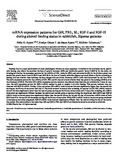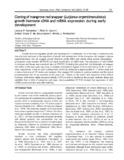| dc.contributor.author | de Jesus, Evelyn Grace T. | |
| dc.contributor.author | Ayson, Felix G. | |
| dc.contributor.author | Amemiya, Yutaka | |
| dc.contributor.author | Moriyama, Shunsuke | |
| dc.contributor.author | Hyodo, Susumu | |
| dc.contributor.author | Hirano, Tetsuya | |
| dc.contributor.author | Kawauchi, Hiroshi | |
| dc.date.accessioned | 2014-01-17T08:52:48Z | |
| dc.date.available | 2014-01-17T08:52:48Z | |
| dc.date.issued | 2002 | |
| dc.identifier.citation | De Jesus, E. G. T., Ayson, F. G., Amemiya, Y., Moriyama, S., Hyodo, S., Hirano, T., & Kawauchi, H. (2002). Milkfish (Chanos chanos) growth hormone cDNA cloning and mRNA expression in embryos and early larval stages. Aquaculture, 208(1-2), 177-188. | en |
| dc.identifier.issn | 0044-8486 | |
| dc.identifier.uri | http://hdl.handle.net/10862/1923 | |
| dc.description.abstract | In an attempt to understand growth regulation in milkfish, the milkfish growth hormone (GH) and its cDNA were characterized and the expression of GH mRNA in embryos and larvae was examined by RT-PCR. The milkfish GH was purified from an alkaline extract of the pituitary by reverse-phase high-performance liquid chromatography and detected as an immuno-positive protein with anti-salmon GH serum. The complete sequence of milkfish pre-GH was determined by cDNA cloning and nucleotide sequencing. On the basis of the N-terminal amino acid analysis of the native protein, the pre-GH was found to consist of a signal peptide of 22 amino acids and a mature protein of 188 amino acids. Milkfish GH shows higher amino acid sequence identity with GHs of carps (91–94%) and salmonids (70%) than with GHs of more advanced teleosts (<60%) in good accordance with its taxonomic position in teleosts. It has five half Cys residues, four of which are at positions homologous with those of other known GHs and the extra Cys with those of carp GHs. The molecular weight of milkfish GH was estimated to be 22 kDa, which is comparable to the theoretical value. This suggests that milkfish GH is a simple protein, although it has two potential N-glycosylation sites. Semiquantitative RT-PCR showed that GH mRNA expression was relatively weak in embryos and newly hatched larvae but was already strong in 2-day old and older larvae. | en |
| dc.language.iso | en | en |
| dc.publisher | Elsevier | en |
| dc.subject | Growth hormone | en |
| dc.subject | mRNA | en |
| dc.subject | Milkfish | en |
| dc.subject | Chanos chanos | en |
| dc.subject | Early development | en |
| dc.subject | mRNA expression | en |
| dc.title | Milkfish (Chanos chanos) growth hormone cDNA cloning and mRNA expression in embryos and early larval stages. | en |
| dc.type | Article | en |
| dc.citation.volume | 208 | |
| dc.citation.issue | 1-2 | |
| dc.citation.spage | 177 | |
| dc.citation.epage | 188 | |
| dc.citation.journalTitle | Aquaculture | en |
| dc.subject.asfa | Amino acid sequence | en |
| dc.subject.asfa | DNA | en |
| dc.subject.asfa | Embryos | en |
| dc.subject.asfa | fish larvae | en |
| dc.subject.asfa | gene expression | en |
| dc.subject.asfa | Growth regulators | en |
| dc.subject.asfa | hormones | en |
| dc.subject.asfa | larvae | en |
| dc.subject.asfa | nucleotide sequence | en |
| dc.subject.asfa | RNA | en |
| dc.subject.asfa | cDNA | en |
| dc.subject.asfa | cloning | en |
| dc.identifier.doi | 10.1016/S0044-8486(01)00759-1 | |
| dc.subject.scientificName | Chanos chanos | |



